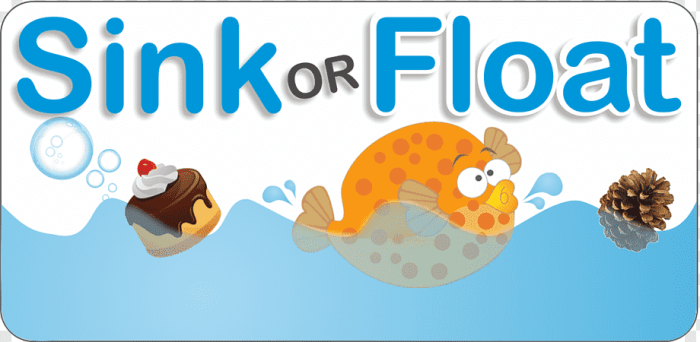Float and Sink Game: An engaging educational tool that sparks curiosity and unravels the mysteries of buoyancy, density, and scientific inquiry.
Embark on an enlightening journey where children and adults alike delve into the captivating world of float and sink, discovering the scientific principles that govern these fascinating phenomena.
Materials for the Float and Sink Game
The float and sink game involves using various materials to create objects that either float on the surface of a liquid or sink to the bottom. The most common materials used in this game include:
- Wood:Wood is a lightweight material that floats due to its low density. Examples include toy boats, wooden blocks, and corks.
- Metal:Metal is a dense material that generally sinks, except for objects with a hollow or sealed structure, such as aluminum cans or metal boats.
- Plastic:Plastic is a versatile material that can either float or sink depending on its density. Examples include plastic bottles (float), plastic toys (float or sink), and plastic bags (float).
- Rubber:Rubber is a flexible material that can either float or sink based on its shape and density. Examples include rubber balls (float), rubber ducks (float), and rubber bands (sink).
| Material | Float/Sink | Examples |
|---|---|---|
| Wood | Float | Toy boats, wooden blocks, corks |
| Metal | Sink | Solid metal objects, coins |
| Plastic | Float | Plastic bottles, plastic toys |
| Rubber | Float | Rubber balls, rubber ducks |
Factors Affecting Buoyancy

Buoyancy is the upward force exerted by a fluid that opposes the weight of a partially or fully immersed object. The following factors affect buoyancy:
- Density:Density is the mass of an object per unit volume. Objects with a density less than the density of the fluid will float, while objects with a density greater than the fluid’s density will sink.
- Shape:The shape of an object can influence its buoyancy. Objects with a streamlined shape experience less resistance from the fluid, allowing them to float more easily.
- Volume:The volume of an object, or the amount of space it occupies, also affects its buoyancy. Larger objects displace more fluid, resulting in greater buoyancy.
For example, a wooden boat floats because its density is lower than the density of water. A metal boat sinks because its density is higher than water’s density. A hollow metal ball floats because its average density, including the enclosed air, is less than the density of water.
Scientific Principles Behind the Game
The float and sink game demonstrates several scientific principles:
- Archimedes’ principle:This principle states that an object immersed in a fluid experiences an upward force equal to the weight of the fluid displaced by the object.
- Concept of displacement:When an object is placed in a fluid, it displaces an equal volume of fluid. The displaced fluid exerts an upward force on the object, known as buoyancy.
These principles can be applied to predict whether an object will float or sink. If the upward buoyant force is greater than the object’s weight, it will float. If the buoyant force is less than the weight, the object will sink.
Educational Value of the Game, Float and sink game

The float and sink game is a valuable educational tool for teaching children about:
- Density:Children can experiment with different materials and observe how their density affects their buoyancy.
- Buoyancy:The game demonstrates the concept of buoyancy and how it affects objects in water.
- Scientific inquiry:The game encourages children to make predictions, test hypotheses, and draw conclusions.
The game can be incorporated into science lessons and activities to reinforce these concepts.
Variations of the Float and Sink Game

There are several variations of the float and sink game:
- Different liquids:Using different liquids with varying densities, such as salt water or oil, can change the float/sink properties of objects.
- Different objects:Using a variety of objects with different shapes, sizes, and materials can make the game more challenging and educational.
- Timed float and sink:This variation involves timing how long it takes for objects to float or sink, allowing children to explore the effects of density and shape on buoyancy.
These variations can enhance the game’s educational value and make it more enjoyable for children.
Questions and Answers
What is the purpose of the Float and Sink Game?
To teach children about buoyancy, density, and scientific inquiry through hands-on experimentation.
What materials are needed for the game?
Common household items such as wood, metal, plastic, rubber, and various liquids.
How can the game be varied to make it more challenging?
By using different liquids with varying densities or by introducing objects with irregular shapes.
